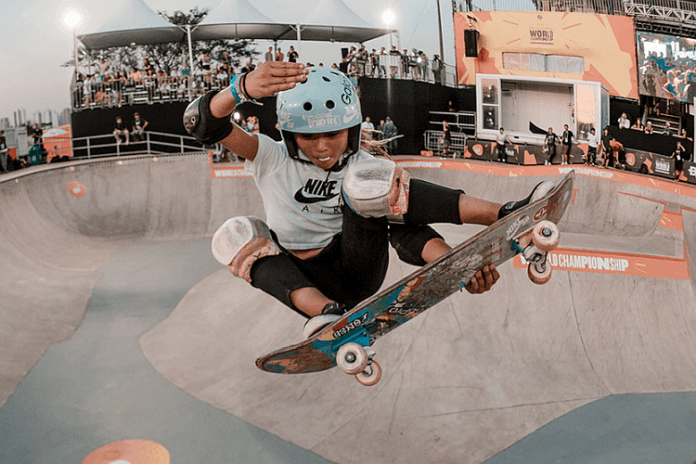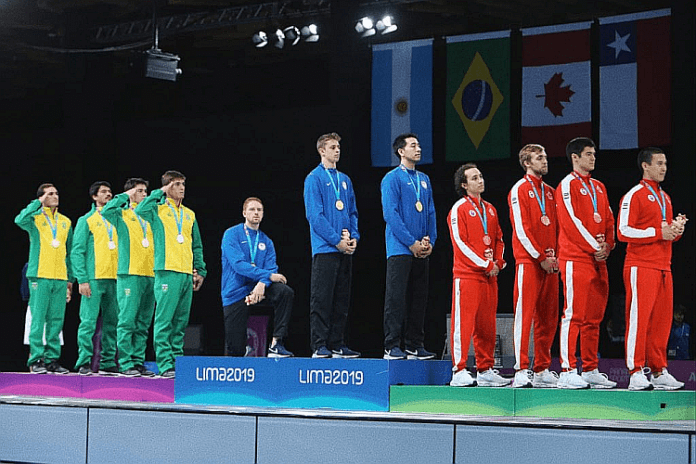(★ Friends: THANK YOU! Several donations are in toward the new bill for server and support costs, and adding in the overage from the prior request, we’re at 40% of our goal. This isn’t the easiest time to ask, but if you would like to help, please donate here. Your enthusiasm is the reason this site continues. ★)
Perhaps the most striking comment on the sports program approved for the 2024 Olympic Games in Paris was this: “breakdancing is in; cross country running isn’t.”
There has been no shortage of both amazement and outrage at the selection of “breaking” as an Olympic sport for 2024, but it is just the latest chapter in the running love affair between the International Olympic Committee and “action” or “urban” sports that dates back 32 years.
Yes, the story is that old. But the story took a significant turn in 2016.
The first pivot point came in October 1985, when the U.S. television network ABC paid a then-staggering $309 million for the rights to the 1988 Olympic Winter Games in Calgary, Canada, more in cash than paid for the 1984 Olympic Games in Los Angeles ($225 million) the year prior!
That put pressure on the IOC to expand the Calgary program to provide more events for ABC to show to American audiences, and the Canadian organizers were more than willing, adding demonstration events in Curling (2 events), Freestyle Skiing (6) and Short Track Speed Skating (10), all part of the standard Winter Games program now.
Although the Federation Internationale de Ski had been running World Cup competitions in Freestyle Skiing since 1980 – in Moguls and Aerials – these events were derided at the time as “hot dogging” and as a judged sport, not in the same class as traditional, timed or measured disciplines like alpine and cross country skiing. But there will be 13 such events at Beijing 2022, more than any of the skiing disciplines.
By 1992, Freestyle events were incorporated into the medal program for Albertville (FRA), but as the Winter Games rights fees went up, so did the appetite for more events. So, when the FIS started its World Cup program for Snowboard in the 1994-95 season – primarily Halfpipe and Parallel – it was only a question of when it would be included. It didn’t take long: Halfpipe and Giant Slalom were added to the 1998 Nagano (JPN) medal program and there will be 11 Snowboard events at Beijing 2022.
While this enormous expansion of “action” events was taking place in the Winter Games, the Olympic Games program was expanding with traditional sports: table tennis and tennis in 1988, badminton and baseball in 1992. But the “action sports” bug caught up with the summer Games in 1996, with beach volleyball and mountain biking added for 1996, trampoline and triathlon events in 2000, and BMX racing in 2008.
But there was considerable concern within the IOC that the Olympic program was not keeping up with the times and more events that appealed to youth were needed. In 2015, the Olympic Studies Centre commissioned a research study by University of Waikato (NZL) Associate Professors Belinda Wheaton and Holly Thorpe, released in 2016 and titled: “Youth Perceptions of the Olympic Games: Attitudes Towards Action Sports at the YOG and Olympic Games.”
If you are looking for the turning point in the IOC’s current obsession with appealing to youth, this is it. The report’s summary crystallized the issue candidly:
“The IOC faces a significant challenge, that is, how to stay relevant to contemporary youth amid changing sport participation and consumption patterns and growing competition from mega-events such as the X Games.”
The report examines, in 137 pages, the possibilities for the IOC, using a survey, a review of media coverage and interviews. The survey was the key. Some 820 individuals were polled on their interest in action sports relative to Olympic inclusion, with 77% either devoted or occasional participants in one or more of these sports and 23% who were not participants. The data showed:
● Survey respondents were from 51 countries, with the most replies from China (24%), followed by Germany (10%) and the U.S. (9%).
● Respondents said they followed the X Games heavily – about 75% – about the same interest level as the Olympic and Winter Games.
● Their favorite action sports to watch on television or online included Skateboarding (36%), Parkour (31%), Snowboarding (30%), Surfing (30%), BMX (25%), Mountain Bike (22%) and Skiing (22%).
● Their favorite Olympic sports, in comparison, were Athletics (26%), Aquatics (25%), Gymnastics (24%) and the various team sports (21%). In the Winter Games, Snowboard was the big winner, at 37%, followed by Alpine Skiing (27%) and Freestyle (24%).
● The key finding came from this question: “How do you feel about the possibility of more action sports being included in the Olympic Games?”
The answer: 60% agreed with “I think this is a great idea and I would likely watch more of the Olympics.”
B-I-N-G-O. Game over.
Just 5% said they don’t want more action sports, 8.5% said they didn’t care and an interesting 22.5% said they didn’t like “what happens to action sports when they become Olympic sports.” That latter group did not say, however, that they would not watch.
And even more important: enthusiasm for adding action sports was across all age groups, with 80.2% of those from 0-19 in favor (!!!), then 53.1% from 20-30; 54.6% from 31-40; 58.5% from 41-50 and 65.0% (!!!) for ages 51 and up!
The report noted “a perception among many of our interviewees that the inclusion of action sports into the Olympic Games signals to an international audience that the IOC is flexible and responding to changing trends in youth sport participation and consumptions.”
Takeaway: add more “action” sports to the Olympic program, NOW.
And that is just what the IOC did, but very, very cleverly.
The first follow-up question had to be which sports should be included. The survey asked this, with the top selections (820 respondents, who could pick multiple events):
● 797 votes: Skateboarding of various kinds (5 types)
● 218 votes: Surfing (2 types)
● 186 votes: BMX Freestyle
● 151 votes: Parkour
● 123 votes: Climbing
It’s no surprise, then, that the Tokyo 2020 organizers submitted a list of add-on sports in September 2015 that included Skateboarding, Sport Climbing and Surfing, in addition to the more traditional sports of Baseball/Softball and Karate.
The experimental nature of the Youth Olympic Games was noted as a good incubator for new events and after Break Dancing was included in the 2018 YOG in Buenos Aires (ARG), lo and behold, the Paris 2024 organizers petitioned for “Breaking” to be included, along with Skateboarding, Sport Climbing and Surfing once again.
Please note that it is the Tokyo and Paris organizers who are asking for these sports, not the IOC imposing them. There is a major difference, in that these are one-time add-ons and the relevant federations – World Skate, the International Federation of Sport Climbing (IFSC), International Surfing Association (ISA) and World DanceSport Federation – do not share in the distribution of IOC television revenues, as do the 28 “core” IFs.
All of these factors make the stakes enormously high for the IOC and all of the sports on the Tokyo 2020 program next summer. What will the television and streaming ratings say about these sports and especially those on the lower rungs of the rankings in viewing popularity:
● Fourth tier: Canoeing, Equestrian, Fencing, Handball, Hockey, Sailing, Taekwondo, Triathlon, Wrestling.
● Fifth tier: Modern Pentathlon, and Golf and Rugby as first-time sports in Rio 2016.
Already, significant changes for Paris 2024 have been made by Canoeing – killing two Sprint races and adding the novelty Extreme Canoe Slalom – and Sailing, which added an action-type event in Kiteboarding and an open-ocean race that is still under consideration. Modern Pentathlon has reinvented itself with finals that will take place in just 90 minutes, all inside a compact, temporary outdoor arena.
Based on the 2016 study by Wheaton and Thorpe, certainly Parkour has to be considered for 2028 (despite a raging battle over federation representation) and then there is the eSports question, certainly a growth area in youth participation and one the IOC is studying intently. And since all of these action add-ons are one-offs, the fate of Skateboarding, Sport Climbing and Surfing will be up for debate again.
In the conclusion of the Wheaton and Thorpe report was this:
“Our results signal important areas for further research, including national differences in perceptions of action sports inclusion into the Olympic Games; the perceptions of youth, and particularly children; mainstream audiences responses to action sports inclusion in Tokyo 2020 Olympic Games; and the effects of Olympic inclusion on gender diversity and global growth and development of action sports.”
The IOC got to 50/50 gender balance in its Paris 2024 program and the Paris organizers have promised to showcase many of the action sports – Basketball 3×3, Break Dancing, Skateboarding, Sport Climbing, Triathlon and the finish of the road races in Athletics and Cycling – in a temporary arena for 30,000 in the Place de la Concorde in the heart of the city.
How Olympic fans respond to these sports vis-a-vis the other sports on the program could signal a 21st Century “French Revolution” in the evolution of the Olympic sports program, starting in Los Angeles in 2028.
Rich Perelman
Editor
You can receive our exclusive TSX Report by e-mail by clicking here. You can also refer a friend by clicking here, and can donate here to keep this site going.
For our 526-event International Sports Calendar from October 2020 to June 2021, by date and by sport, click here!























